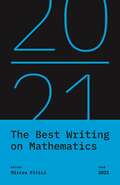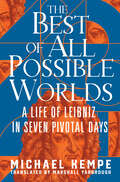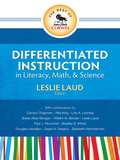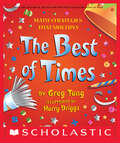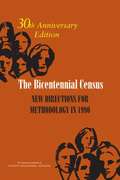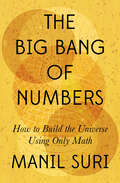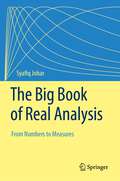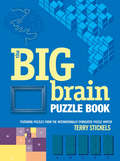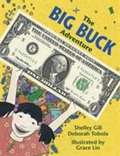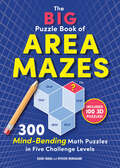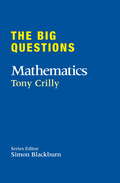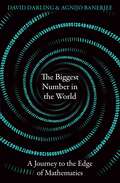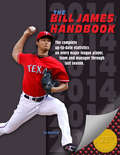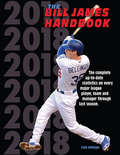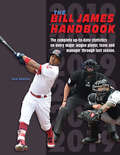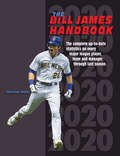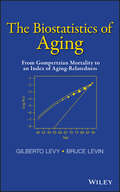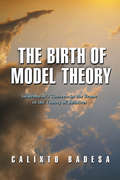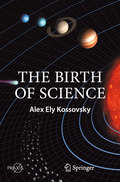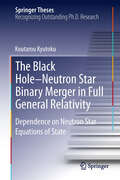- Table View
- List View
The Best Writing on Mathematics 2021 (The Best Writing on Mathematics #20)
by Mircea PiticiThe year’s finest mathematical writing from around the worldThis annual anthology brings together the year’s finest mathematics writing from around the world—and you don’t need to be a mathematician to enjoy the pieces collected here. These essays—from leading names and fresh new voices—delve into the history, philosophy, teaching, and everyday aspects of math, offering surprising insights into its nature, meaning, and practice, and taking readers behind the scenes of today’s hottest mathematical debates.Here, Viktor Blåsjö gives a brief history of “lockdown mathematics”; Yelda Nasifoglu decodes the politics of a seventeenth-century play in which the characters are geometric shapes; and Andrew Lewis-Pye explains the basic algorithmic rules and computational procedures behind cryptocurrencies. In other essays, Terence Tao candidly recalls the adventures and misadventures of growing up to become a leading mathematician; Natalie Wolchover shows how old math gives new clues about whether time really flows; and David Hand discusses the problem of “dark data”—information that is missing or ignored. And there is much, much more.
The Best of All Possible Worlds: A Life of Leibniz in Seven Pivotal Days
by Michael KempeA biography of the polymath Gottfried Wilhelm Leibniz told through seven critical days spanning his life and revealing his contributions to our modern world. Gottfried Wilhelm Leibniz (1646–1716) was the Benjamin Franklin of Europe, a “universal genius” who ranged across many fields and made breakthroughs in most of them. Leibniz invented calculus (independently from Isaac Newton), conceptualized the modern computer, and developed the famous thesis that the existing world is the best that God could have created. In The Best of All Possible Worlds, historian and Leibniz expert Michael Kempe takes us on a journey into the mind and inventions of a man whose contributions are perhaps without parallel in human history. Structured around seven crucial days in Leibniz’s life, Kempe’s account allows us to observe him in the act of thinking and creating, and gives us a deeper understanding of his broad-reaching intellectual endeavors. On October 29, 1675, we find him in Paris, diligently working from his bed amid a sea of notes, and committing the integral symbol—the basis of his calculus—to paper. On April 17, 1703, Leibniz is in Berlin, writing a letter reporting that a Jesuit priest living in China has discovered how to use Leibniz’s binary number system to decipher an ancient Chinese system of writing. One day in August 1714, Leibniz enjoys a Viennese coffee while drawing new connections among ontology and biology and mathematics. The Best of All Possible Worlds transports us to an age defined by rational optimism and a belief in progress, and will endure as one of the few authoritative accounts of Leibniz’s life available in English.
The Best of Corwin: Differentiated Instruction in Literacy, Math, and Science
by Leslie E. LaudContent-specific DI guidance from the best minds in education In this collection, current research on the most effective differentiation practices for differentiating instruction in literacy, mathematics, and scienceis brought alive through the many strategies and examples. Topics covered include: Reading and writing: A comprehensive array of models for differentiating reading instruction; gradual release of responsibility to accelerate progress; and multi-tiered writing instruction Mathematics: Support for both low- and high-achieving students, including interventions and challenges, and the implementation of RTI in math instruction Science: Models and methods for increasing student achievement through differentiated science inquiry
The Best of Times: Math Strategies That Multiply
by Greg Tang Harry BriggsNEW YORK TIMES bestselling author Greg Tang takes on the times tables, teaching kids innovative ways to multiply numbers and derive answers WITHOUT memorization. Four is very fast to do when you multiply by 2. Here's a little good advice -- please just always double twice! BEST OF TIMES gives kids an intuitive understanding of multiplication, encouraging them to arrive at answers on their own rather than memorizing the times tables. A child who can multiply by two, for instance, can multiply by four and even eight! Likewise, times six builds on times two and times three. With his common-sense approach, Greg Tang encourages kids to solve problems creatively, building both their skills and their confidence.
The Best of Times: Math Strategies that Multiply
by Greg TangNEW YORK TIMES bestselling author Greg Tang takes on the times tables, teaching kids innovative ways to multiply numbers and derive answers WITHOUT memorization.Four is very fast to do when you multiply by 2.Here's a little good advice --please just always double twice!BEST OF TIMES gives kids an intuitive understanding of multiplication, encouraging them to arrive at answers on their own rather than memorizing the times tables. A child who can multiply by two, for instance, can multiply by four and even eight! Likewise, times six builds on times two and times three.With his common-sense approach, Greg Tang encourages kids to solve problems creatively, building both their skills and their confidence.
The Bicentennial Census: 30th Anniversary Edition
by Constance F. CitroIn 1982 the Census Bureau requested the Committee on National Statistics to establish a panel to suggest research and experiments, to recommend improved methods, and to guide the Census Bureau on technical problems in appraising contending methods with regard to the conduct of the decennial census. In response, the panel produced an interim report that focused on recommendations for improvements in census methodology that warranted early investigation and testing. This report updates and expands the ideas and conclusions about decennial census methodology.
The Big Bang of Numbers: How to Build the Universe Using Only Math
by Manil SuriAn engaging and imaginative tour through the fundamental mathematical concepts—from arithmetic to infinity—that form the building blocks of our universe. Our universe has multiple origin stories, from religious creation myths to the Big Bang of scientists. But if we leave those behind and start from nothing—no matter, no cosmos, not even empty space—could we create a universe using only math? Irreverent, richly illustrated, and boundlessly creative, The Big Bang of Numbers invites us to try. In this new mathematical origin story, mathematician and novelist Manil Suri creates a natural progression of ideas needed to design our world, starting with numbers and continuing through geometry, algebra, and beyond. He reveals the secret lives of real and imaginary numbers, teaches them to play abstract games with real-world applications, discovers unexpected patterns that connect humble lifeforms to enormous galaxies, and explores mathematical underpinnings for randomness and beauty. With evocative examples ranging from multidimensional crochet to the Mona Lisa’s asymmetrical smile, as well as ingenious storytelling that helps illuminate complex concepts like infinity and relativity, The Big Bang of Numbers charts a playful, inventive course to existence. Mathematics, Suri shows, might best be understood not as something we invent to explain Nature, but as the source of all creation, whose directives Nature tries to obey as best she can. Offering both striking new perspectives for math aficionados and an accessible introduction for anyone daunted by calculation, The Big Bang of Numbers proves that we can all fall in love with math.
The Big Book of Real Analysis: From Numbers to Measures
by Syafiq JoharThis book provides an introduction to real analysis, a fundamental topic that is an essential requirement in the study of mathematics. It deals with the concepts of infinity and limits, which are the cornerstones in the development of calculus. Beginning with some basic proof techniques and the notions of sets and functions, the book rigorously constructs the real numbers and their related structures from the natural numbers. During this construction, the readers will encounter the notions of infinity, limits, real sequences, and real series. These concepts are then formalised and focused on as stand-alone objects. Finally, they are expanded to limits, sequences, and series of more general objects such as real-valued functions. Once the fundamental tools of the trade have been established, the readers are led into the classical study of calculus (continuity, differentiation, and Riemann integration) from first principles. The book concludes with an introduction to the study of measures and how one can construct the Lebesgue integral as an extension of the Riemann integral. This textbook is aimed at undergraduate students in mathematics. As its title suggests, it covers a large amount of material, which can be taught in around three semesters. Many remarks and examples help to motivate and provide intuition for the abstract theoretical concepts discussed. In addition, more than 600 exercises are included in the book, some of which will lead the readers to more advanced topics and could be suitable for independent study projects. Since the book is fully self-contained, it is also ideal for self-study.
The Big Brain Puzzle Book: Entertaining Sudoku, Kakuro, And Brainteasers For Every Day (Little Bathroom Book Ser.)
by Terry StickelsGive your brain a series of workouts that'll make it bigger and better! This colossal collection of more than 200 puzzles simultaneously provides a relaxing atmosphere for mental play and stimulates brain activity. Created by an internationally renowned puzzle-maker, the challenges involve creative thinking, mathematics, logic, language and wordplay, visuals, and general knowledge.Kick start your neurons at Level 1 with puzzles involving hidden words, math calculations, and logical conundrums. At Level 2, fire up your synapses with cryptograms, scrambled sentences, and visual challenges. And activate your brain at Level 3 with fill-in-the-blanks, search-a-words, magic squares, and much more. If you get stumped, an answer key with complete solutions appears at the end.
The Big Buck Adventure
by Shelley Gill Grace Lin Deborah TobolaOne little girl and one very big dollar set out on a great adventure at the store. <P><P> However, what seems like a pleasant afternoon of shopping soon turns perplexing as the challenge of her buying options becomes overwhelming. She doesn't know what to do. There are so many choices, but she only has one buck. A fun and perfect example of how we use math in our daily lives.
The Big Puzzle Book of Area Mazes: 300 Mind-bending Math Puzzles In Five Challenge Levels (Original Area Mazes #0)
by Naoki Inaba Ryoichi MurakamiStretch your brain up, down, and sideways with addictive area mazes! Introducing a new puzzle obsession for sodoku lovers . . . amazing, absorbing area mazes. First invented for gifted students, area mazes blend grade-school math with genius logic. Put down that calculator! You can always find "?" using simple, whole numbers, your wits—and a pencil. Already hooked on area mazes? Venture into the third dimension with 100 3D puzzles, included here for the first time by creator Naoki Inaba. With 300 perplexing problems in all, The Big Puzzle Book of Area Mazes offers hours of brain-building fun, from scratching your head to shouting "aha"!
The Big Questions: Mathematics
by Tony CrillyIn Big Questions: Mathematics, Tony Crilly answers the 20 key questions:What is math for? Where do numbers come from? Why are primes the atoms of maths? Which are the strangest numbers? Are imaginary numbers real? How big is infinity? Where do parallel lines meet? What is the math of the universe? Are statistics lies? Can math guarantee riches? Is there a formula for everything? Why are three dimensions not enough? Can a butterfly's wings really cause a hurricane? Can we create an unbreakable code? Is math beauty? Can math predict the future? What shape is the universe? What is symmetry? Is math true? Is there anything left to solve?
The Big Questions: Mathematics
by Tony CrillyThe Big Questions series is designed to let renowned experts address the 20 most fundamental and frequently asked questions of a major branch of science or philosophy. Each 3000-word essay simply and concisely examines a question that has eternally perplexed enquiring minds, and provides answers from history's great thinkers. This ambitious project is a unique distillation of humanity's best ideas. In Big Questions: Mathematics, Tony Crilly answers the 20 key questions: What is maths for? Where do numbers come from? Why are primes the atoms of maths? What are the strangest numbers? Are imaginary numbers real? How big is infinity? Where do parallel lines meet? What is the maths of the universe? Are statistics lies? Can maths guarantee riches? Is there a formula for everything? Why are three dimensions not enough? Can a butterfly's wings really cause a hurricane? Can we create an unbreakable code? Is maths beauty? Can maths predict the future? What shape is the universe? What is symmetry? Is maths true? Is there anything left to solve?
The Big Questions: Mathematics
by Tony CrillyThe Big Questions series is designed to let renowned experts address the 20 most fundamental and frequently asked questions of a major branch of science or philosophy. Each 3000-word essay simply and concisely examines a question that has eternally perplexed enquiring minds, and provides answers from history's great thinkers. This ambitious project is a unique distillation of humanity's best ideas. In Big Questions: Mathematics, Tony Crilly answers the 20 key questions: What is maths for? Where do numbers come from? Why are primes the atoms of maths? What are the strangest numbers? Are imaginary numbers real? How big is infinity? Where do parallel lines meet? What is the maths of the universe? Are statistics lies? Can maths guarantee riches? Is there a formula for everything? Why are three dimensions not enough? Can a butterfly's wings really cause a hurricane? Can we create an unbreakable code? Is maths beauty? Can maths predict the future? What shape is the universe? What is symmetry? Is maths true? Is there anything left to solve?
The Big R-Book: From Data Science to Learning Machines and Big Data
by Philippe J. De BrouwerIntroduces professionals and scientists to statistics and machine learning using the programming language R Written by and for practitioners, this book provides an overall introduction to R, focusing on tools and methods commonly used in data science, and placing emphasis on practice and business use. It covers a wide range of topics in a single volume, including big data, databases, statistical machine learning, data wrangling, data visualization, and the reporting of results. The topics covered are all important for someone with a science/math background that is looking to quickly learn several practical technologies to enter or transition to the growing field of data science. The Big R-Book for Professionals: From Data Science to Learning Machines and Reporting with R includes nine parts, starting with an introduction to the subject and followed by an overview of R and elements of statistics. The third part revolves around data, while the fourth focuses on data wrangling. Part 5 teaches readers about exploring data. In Part 6 we learn to build models, Part 7 introduces the reader to the reality in companies, Part 8 covers reports and interactive applications and finally Part 9 introduces the reader to big data and performance computing. It also includes some helpful appendices. Provides a practical guide for non-experts with a focus on business users Contains a unique combination of topics including an introduction to R, machine learning, mathematical models, data wrangling, and reporting Uses a practical tone and integrates multiple topics in a coherent framework Demystifies the hype around machine learning and AI by enabling readers to understand the provided models and program them in R Shows readers how to visualize results in static and interactive reports Supplementary materials includes PDF slides based on the book’s content, as well as all the extracted R-code and is available to everyone on a Wiley Book Companion Site The Big R-Book is an excellent guide for science technology, engineering, or mathematics students who wish to make a successful transition from the academic world to the professional. It will also appeal to all young data scientists, quantitative analysts, and analytics professionals, as well as those who make mathematical models.
The Biggest Number in the World: A Journey to the Edge of Mathematics
by David Darling Agnijo BanerjeeFrom cells in our bodies to measuring the universe, big numbers are everywhere We all know that numbers go on forever, that you could spend your life counting and never reach the end of the line, so there can&’t be such a thing as a &‘biggest number&’. Or can there? To find out, David Darling and Agnijo Banerjee embark on an epic quest, revealing the answers to questions like: are there more grains of sand on Earth or stars in the universe? Is there enough paper on Earth to write out the digits of a googolplex? And what is a googolplex? Then things get serious. Enter the strange realm between the finite and the infinite, and float through a universe where the rules we cling to no longer apply. Encounter the highest number computable and infinite kinds of infinity. At every turn, a cast of wild and wonderful characters threatens the status quo with their ideas, and each time the numbers get larger.
The Bill James Handbook 2014
by Bill JamesThe Bill James Handbook--the first, best, most complete annual baseball reference guide available. Full of exclusive stats, this book is the most comprehensive resource on every hit, pitch, and catch in Major League Baseball's 2013 season--and includes player projections for 2014. Key features include: NEW sections: No-Hitter Summary; Home Run Robberies; Hitter Analysis; and returning favorites: Career Baserunning; Pitcher Analysis; Pitch Repertoire Section; Rotation vs. Bullpen.
The Bill James Handbook 2017
by Bill James Baseball Info SolutionsBill James and the Baseball Info Solutions team of analysts continue to pack in new content, including a fresh look at the continued rise and effectiveness of The Shift and a new breakdown of home runs and long flyouts. And, as always, the book forecasts fresh hitter and pitcher projections for those looking to get an early jump on the next season.
The Bill James Handbook 2018
by Bill James Baseball Info SolutionsBill James and Baseball Info Solutions team of analysts continue to pack in new content, including a fresh look at the continues rise and effectiveness of The Shift and a new breakdown of home runs and long flyouts. And, as always, the book forecasts fresh hitter and pitcher projections for those looking to get an early jump on the next season.</
The Bill James Handbook 2019
by Bill James Baseball Info SolutionsBill James and Baseball Info Solutions team of analysts continue to pack in new content, including a fresh look at the continues rise and effectiveness of The Shift and a new breakdown of home runs and long flyouts. And, as always, the book forecasts fresh hitter and pitcher projections for those looking to get an early jump on the next season.</
The Bill James Handbook 2020
by Bill James Baseball Info SolutionsThe first-to-market, most comprehensive, insightful, and groundbreaking annual baseball book on the market. A must-have book or gift for every true fan, with lifetime statistics and leader boards for every player in the major leagues and projections for how they might do in the future.
The Biostatistics of Aging
by Bruce Levin Gilberto LevyA practical and clarifying approach to aging and aging-related diseasesProviding a thorough and extensive theoretical framework, The Biostatistics of Aging: From Gompertzian Mortality to an Index of Aging-Relatedness addresses the surprisingly subtlenotion--with consequential biomedical and public health relevance--of what it means for acondition to be related to aging. In this pursuit, the book presents a new quantitative methodto examine the relative contributions of genetic and environmental factors to mortality anddisease incidence in a population.With input from evolutionary biology, population genetics, demography, and epidemiology, this medically motivated book describes an index of aging-relatedness and also features:Original results on the asymptotic behavior of the minimum of time-to-event random variables, which extends those of the classical statistical theory of extreme valuesA comprehensive and satisfactory explanation based on biological principles of the Gompertz pattern of mortality in human populationsThe development of an evolution-based model of causation relevant to mortality and aging-related diseases of complex etiologyAn explanation of how and why the description of human mortality by the Gompertz distribution can be improved upon from first principlesThe amply illustrated analysis of real-world data, including a program for conducting the analysis written in the freely available R statistical softwareTechnical appendices including mathematical material as well as an extensive and multidisciplinary bibliography on aging and aging-related diseasesThe Biostatistics of Aging: From Gompertzian Mortality to an Index of Aging-Relatedness is an excellent resource for practitioners and researchers with an interest in aging and aging-related diseases from the fields of medicine, biology, gerontology, biostatistics, epidemiology, demography, and public health.
The Birth of Model Theory: Löwenheim's Theorem in the Frame of the Theory of Relatives
by Calixto BadesaLöwenheim's theorem reflects a critical point in the history of mathematical logic, for it marks the birth of model theory--that is, the part of logic that concerns the relationship between formal theories and their models. However, while the original proofs of other, comparably significant theorems are well understood, this is not the case with Löwenheim's theorem. For example, the very result that scholars attribute to Löwenheim today is not the one that Skolem--a logician raised in the algebraic tradition, like Löwenheim--appears to have attributed to him. In The Birth of Model Theory, Calixto Badesa provides both the first sustained, book-length analysis of Löwenheim's proof and a detailed description of the theoretical framework--and, in particular, of the algebraic tradition--that made the theorem possible. Badesa's three main conclusions amount to a completely new interpretation of the proof, one that sharply contradicts the core of modern scholarship on the topic. First, Löwenheim did not use an infinitary language to prove his theorem; second, the functional interpretation of Löwenheim's normal form is anachronistic, and inappropriate for reconstructing the proof; and third, Löwenheim did not aim to prove the theorem's weakest version but the stronger version Skolem attributed to him. This book will be of considerable interest to historians of logic, logicians, philosophers of logic, and philosophers of mathematics.
The Birth of Science (Springer Praxis Books)
by Alex Ely KossovskyThis book reveals the multi-generational process involved in humanity's first major scientific achievement, namely the discovery of modern physics, and examines the personal lives of six of the intellectual giants involved. It explores the profound revolution in the way of thinking, and in particular the successful refutation of the school of thought inherited from the Greeks, which focused on the perfection and immutability of the celestial world. In addition, the emergence of the scientific method and the adoption of mathematics as the central tool in scientific endeavors are discussed. The book then explores the delicate thread between pure philosophy, grand unifying theories, and verifiable real-life scientific facts. Lastly, it turns to Kepler’s crucial 3rd law and shows how it was derived from a mere six data points, corresponding to the six planets known at the time. Written in a straightforward and accessible style, the book will inform and fascinate all aficionados of science, history, philosophy, and, in particular, astronomy.
The Black Hole-Neutron Star Binary Merger in Full General Relativity
by Koutarou KyutokuThis thesis presents a systematic study of the orbital evolution, gravitational wave radiation, and merger remnant of the black hole-neutron star binary merger in full general relativity for the first time. Numerical-relativity simulations are performed using an adaptive mesh refinement code, SimulAtor for Compact objects in Relativistic Astrophysics (SACRA), which adopts a wide variety of zero-temperature equations of state for the neutron star matter. Gravitational waves provide us with quantitative information on the neutron star compactness and equation of state via the cutoff frequency in the spectra, if tidal disruption of the neutron star occurs before the binary merges. The cutoff frequency will be observed by next-generation laser interferometric ground-based gravitational wave detectors, such as Advanced LIGO, Advanced VIRGO, and KAGRA. The author has also determined that the mass of remnant disks are sufficient for the remnant black hole accretion disk to become a progenitor of short-hard gamma ray bursts accompanied by tidal disruptions and suggests that overspinning black holes may not be formed after the merger of even an extremely spinning black hole and an irrotational neutron star.
